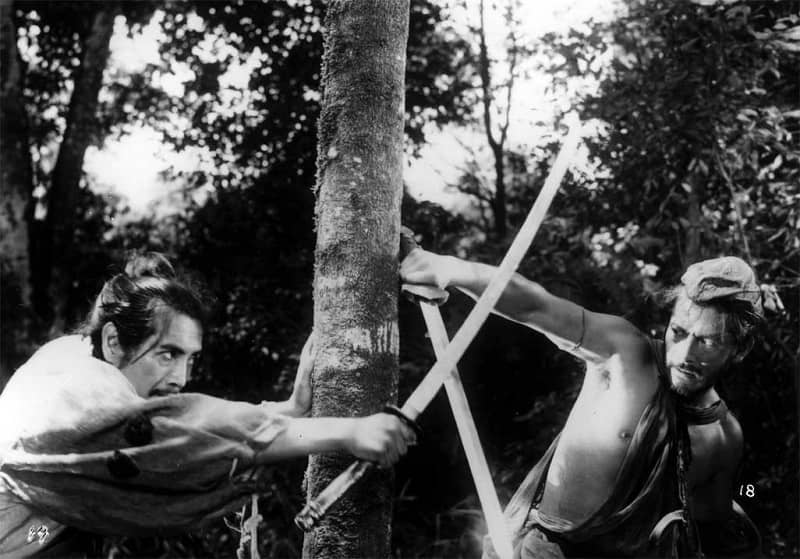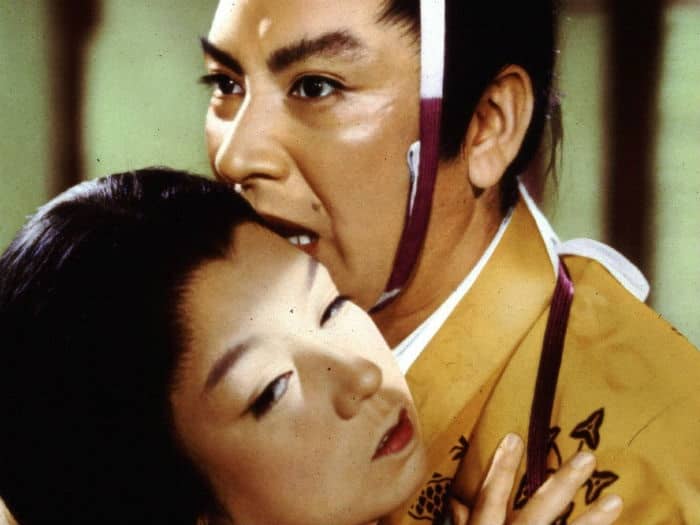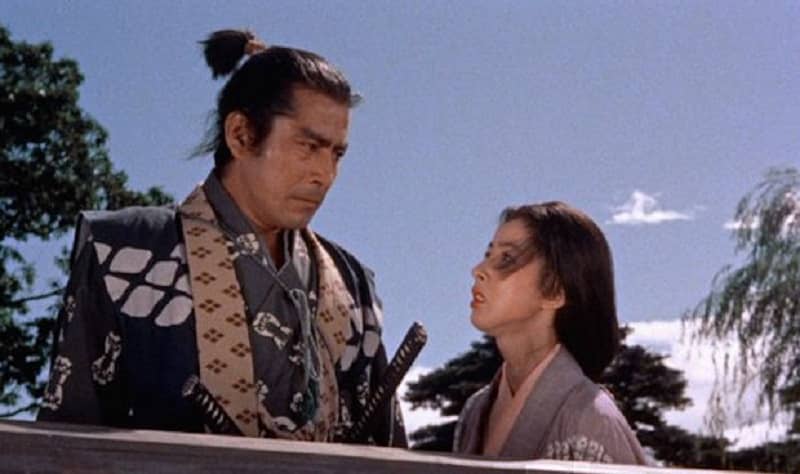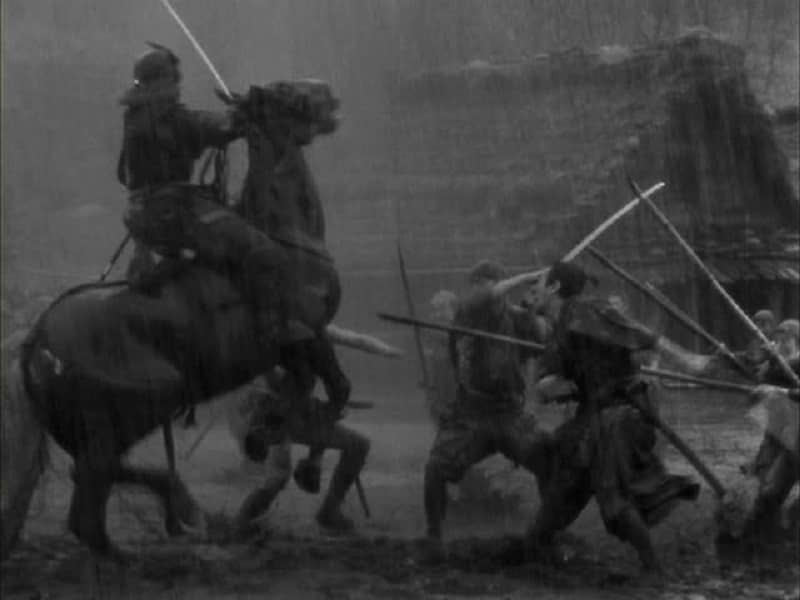Ellsworth’s Cinema of Swords: Eleven Samurai: Early Chambara Classics
As the Japanese economy recovered from the disaster of World War II, its film industry rebounded as well, though under the American occupation the kinds of films that could be made were strictly limited. Censorship on themes of nationalism and warfare was in force until 1952, but once the ban was lifted the industry returned to the popular genre of historical dramas, making some of the finest films ever produced in Japan.
Rashomon
Rating: *****
Origin: Japan, 1950
Director: Akira Kurosawa
Source: Criterion Collection DVD
Although this is director Akira Kurosawa’s first samurai film, it arguably doesn’t belong in the Cinema of Swords as it’s not really a chambara — a swordplay movie — but rather a historical crime tale. You probably have a general idea of what it’s about even if you’ve never seen it, as its title has come to stand for the principle of the unreliable narrator, the same story told differently from several different viewpoints. In this case it’s the history of a crime, a rape and a murder in a lonely grove on a remote wooded mountain. The tale is told from four different points of view, and the viewer is left to tease out the truth for themselves.
The film stars Kurosawa’s favorite leading man, Toshiro Mifune, as a fierce and antic bandit, a character that prefigures his unforgettable Kikuchiyo in The Seven Samurai, and several other actors familiar from that masterpiece show up as well. It’s a striking movie, gorgeously shot in a sun-dappled forest and a relentless downpour, displaying the firm grasp Kurosawa had of the movie-making art even this early in his long career. There’s even a touch of the ghost story to it, as the murdered man tells his own version of events. And of course there is that one pivotal sword duel between the samurai (Masayuki Mori) and Mifune’s bandit — which is one more than you’ll find in swashbuckler The Scarlet Pimpernel (1935), so I guess this film qualifies after all.
Gate of Hell
Rating: *****
Origin: Japan, 1953
Director: Teinosuke Kinugasa
Source: Criterion Collection
This samurai tragedy is really more of a jidaigeki, a period costume drama, than a chambara or swordplay movie, though there’s plenty of colorful action in the first third of its running time. Unlike most samurai films, which are typically set during the Shogunate of the 16th-19th centuries, this takes place in the earlier Heian period of the 12th century, when the relationship between the imperial noble class and the samurai warrior class was still evolving. During a military rebellion against the imperial court, Morito (Kazuo Hasegawa), a fierce fighter, sides with the samurai loyal to the emperor, and in the chaos is assigned to conduct a diversion, a mission escorting a lady impersonating the empress in an apparent attempt to escape the rebel soldiers. He succeeds, but in the process is smitten with the beauty, poise, and courage of Lady Kesa (Machiko Kyo), the woman who performs the imposture. When the battle is over, she disappears, and Morito doesn’t see her again until after the rebellion is put down, when he encounters her by chance and his feelings are rekindled.
Peace restored, when the samurai who stayed loyal are being rewarded by Lord Kiyomori, Morito asks him for Lady Kesa’s hand, and only then learns that she’s already married to a noble of the Court. Morito, obsessed, vows to win her for himself regardless, and matters quickly go from bad to worse. Director Teinosuke Kinugasa’s pacing is masterful, ratcheting up the tension as the story marches toward its crushing end. This was Japan’s first big-budget color film, and even by today’s standards it’s drop-dead gorgeous, simply exquisite, a painting come to life. Kinugasa deliberately contrasts the serenity of nature with the violence of human emotions, but without judgment or sentimentality, allowing the characters and their actions to speak to the viewer for themselves. And all in eighty-six minutes, without a second wasted. What a treasure.
Samurai I: Musashi Miyamoto
Rating: ****
Origin: Japan, 1954
Director: Hiroshi Inagaki
Source: Criterion Collection DVD
Toshiro Mifune, still relatively early in his career, stars as Musashi Miyamoto, the Japanese culture hero who virtually defines Bushido, the warrior code of the samurai. This is the first movie in a trilogy adapting Eiji Yoshikawa’s long (really long) novel fictionalizing Musashi’s early life, originally serialized from 1935 to 1939. Director Hiroshi Inagaki was such a big fan of the work that this is the second trilogy he’d made from it: unfortunately the first three films, made in 1940 to 1942, are now lost.
Though we Westerners most often associate Mifune with the classic films of the great director Akira Kurosawa, he actually made more movies with Inagaki, working with him from the mid-forties to the end of the sixties. This prestige film for the Toho studio was their first big-budget production together, and it was a hit even overseas, where it won the Best Foreign Film Oscar in 1955. It’s certainly gorgeous: Inagaki was a master of color, though unlike Kurosawa his compositions tend to be more pretty than striking. He was as adept with character scenes as with action, and his establishing shots of the Japanese countryside are beautiful.
The film opens with Musashi in his late teens, a country samurai still known as Takezo. He and his friend Matahachi (Rentaro Mikuni) naively leave their small town to find fame and glory as warriors, joining the local army on the eve of the Battle of Sekigahara (1600). Unfortunately, the side they join is the losing one, and they must flee to avoid the massacre of their army’s survivors. They fall in with petty criminals, a woman and her daughter who’ve been fencing stolen goods for a band of brigands, and for the first time Takezo shows his talent for fighting by driving the brigands away and killing their leader — all with a wooden sword! We then enter soap opera territory for a while as the female crooks vie with hometown girl Otsu (Kaoru Yachigusa) for the affections of Takezo and Matahachi. This sets up Takezo’s long, hopeless love affair with Otsu, which will be the romantic pulse of the rest of the trilogy.
On his way to see Otsu, Takezo is detained at a checkpoint, rashly cuts his way through the soldiers, and from that point on he’s a hunted outlaw. He goes from bad to worse, a feral fugitive in the woods lashing out at the hapless peasant troops sent to capture him, until a Buddhist priest named Takuan (Kuroemon Onoe) uses Otsu as bait and takes him into his personal custody. Sensing a powerful spirit beneath the savagery, Takuan sets out to tame the wild Takezo, hanging him bound for a tree for days to teach him humility, and eventually locking him in a castle attic with nothing but a library of books.
Mifune is great as Takezo, angry at the world, yet unsure of himself and vulnerable, perfectly offset by Onoe as the jovial but steely priest. And Yachigusa is appealing and determined as Otsu, initially afraid of Takezo yet inescapably drawn to the wild man’s vulnerable heart. The priest’s firm persistence wins out, redirecting Takezo’s strength and spirit until he’s transformed and renamed into the self-controlled Musashi, who then sets out to find wisdom as a wandering swordsman. (Like you do.)
The historical Musashi, who fought his first duel at thirteen, avoided all romantic attachments, never served a samurai lord, and eventually wrote the classic Book of Five Rings (c. 1643), was a far more unorthodox man than the rather conventionally noble samurai represented in Inagaki’s trilogy. But Samurai I nonetheless does a fine job of setting up Musashi’s spiritual journey (with swordplay interludes) to follow.
The Seven Samurai
Rating: ***** (Essential)
Origin: Japan, 1954
Director: Akira Kurosawa
Source: Criterion Blu-Ray
When your profession is killing people, messily, with hand weapons, how do you reconcile that with trying to do right in the world?
My father, an engineer from the Bronx who aspired to culture, first took me to a then-rare showing of The Seven Samurai when I was twelve or thirteen. It mostly went by in a blur but some of the more vivid scenes stuck with me, indelible, embedded, and when I saw it again as an adult many years later I was amazed by how clearly I remembered parts of it.
Nowadays I re-watch it about once a year, and every time — every time — new details leap out at me, touches that were deliberately placed by Kurosawa, each designed to reveal some aspect of the humanity of the farmers, the bandits who prey on them, and the seven samurai who come to defend them. And I shake my head and wonder, how have I always missed that?
If you’re reading this, it must be because you’re interested in the kinds of movies I post about — but maybe you’ve never seen this film, despite its reputation. Maybe you’ve been put off by the fact that it’s subtitled, or in black and white, or because it’s over three hours long, and who wants to sit through all that? Believe me: you do. With this film director Akira Kurosawa set out to create a historical epic that would be unfailingly entertaining and at the same time truthful, about its time and place, about the people who lived through it, and about how people of all times try to find the heart and courage to face up to danger and fear. And he succeeded.
Technically, this film is a marvel of performance, of composition and photography, and most of all genius-level editing: long as it is, every scene moves the story relentlessly forward, and there’s not an ounce of fat on it.
And the characters, so sharply drawn, so unforgettable: Takashi Shimura as Kambei, the imperturbable but warm and wise veteran who leads the samurai in their hopeless and thankless task; Toshiro Mifune as Kikuchiyo, the wild-man of no background who earns his place among the haughty warrior caste; even the farmers, such as Bokuzen Hidari as Yohei the terrified, who has the world’s saddest face, but finds capabilities within himself he never suspected. And that’s just a few of many remarkable performances, because a film about how a society at odds with itself manages to survive that conflict needs a big cast to carry such a theme off — and that cast must come across as real people living real lives, not play-actors going through the motions. A large part of Kurosawa’s genius as a storyteller is that he loves every one of these characters, as much for their flaws as for their strengths.
Much of the rest of Kurosawa’s genius is his feel for movement. As mentioned above, every scene moves, and none more so than the amazing combat sequences, which despite being muddy, bloody, rain-drenched, and fast as hell, are marvels of cinematic clarity that are also completely convincing. Exhausting. Draining. Exalting. And horrible.
Who wins? You know the story, even if you’ve seen it only in remakes, as The Magnificent Seven, or Battle Beyond the Stars, or even A Bug’s Life. The warriors fight and die, because that’s what warriors do, while the farmers, who survive to carry society on, are the winners. The farmers — and us.
Next year I get to watch it again.
Previous installments in the Cinema of Swords:
Olivia de Havilland — First Queen of the Swashbucklers
Goofballs in Harem Pants
Disney’s Early Swashbucklers
‘50s Vikings – Havoc in Horned Helms
Laughing Cavaliers
Charming and Dangerous: Douglas Fairbanks, Jr.
LAWRENCE ELLSWORTH is deep in his current mega-project, editing and translating new, contemporary English editions of all the works in Alexandre Dumas’s Musketeers Cycle. Three volumes are in print, with the fourth, Blood Royal, coming from Pegasus Books this fall. His website is Swashbucklingadventure.net.
Lawrence Ellsworth’s secret identity is game designer LAWRENCE SCHICK, who’s been designing role-playing games since the 1970s. He now lives in Dublin, Ireland, and is co-designing a new mobile RPG for the WarDucks game studio.




I think I saw “Samurai I” in bits and pieces like back in the 80s. I watched “Seven Samurai” in college in the early 90s–a great film! Also, a long film. We tried to watch it at one of the local art museums but could only get through the first four samurai! It was like 11 o’clock!
I have been loving this column, and it was a great surprise to see Chanbara appear as well! So many great possibilities! I am going to have to look up Gate of Hell now.
The Samurai Trilogy remains among my favorites, but Seven Samurai…that is a film that is something else altogether. As you say, there is so much packed into that three hours, it’s just astounding.
Thank you, Mr. Ellsworth. I say, see every chambara film you can, but if you can only watch four, then these are the ones to see.
Whatever you do, however you do it, WATCH The Seven Samurai. Do it in 30 or 60 minute chunks if you have to but watch this movie; there is so much in it and so well done that you won’t regret it.
I’ve enjoyed each of these posts but this is my favorite thus far.
Seven Samurai is one of the handful of classic films that deserves every bit of the praise and adulation it has garnered down the years and it was stirring to read your righteous salute to it.
But these are the (ahem) classy samurai flicks. I’m hoping you’ll devote a post or two to the true chambara flicks. Bring on Zatoichi, the Lone Wolf, Ocho the gambler, Samurai Wolf and the Master of the Full Moon Cut!
John Hocking: Oh, we’ll get there!